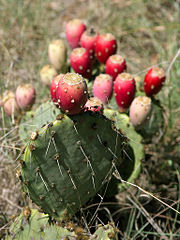Cindi Bower
 The prickly pear cactus is the source of two staples in the Mexican diet: nopales, the cactus pads, and tuna, the fruit. The fruits vary in color from yellow-orange to red to nearly purple, but the red fruit is the best tasting and most popular. Harvest time is late summer into early fall. Once the fruit is plucked from the cactus, it needs to be used quickly as it will begin to ferment.
The prickly pear cactus is the source of two staples in the Mexican diet: nopales, the cactus pads, and tuna, the fruit. The fruits vary in color from yellow-orange to red to nearly purple, but the red fruit is the best tasting and most popular. Harvest time is late summer into early fall. Once the fruit is plucked from the cactus, it needs to be used quickly as it will begin to ferment.This cactus is found in the southwestern deserts of the United States through Mexico and Central America and into South America. It can also be found in southern Europe around the Mediterranean Sea.
Some people claim the pectin in the fruit lowers "bad" cholesterol levels and reduces the need for insulin in diabetics. Studies are being done to test these claims, but there are no definitive results at the present time.
Prickly pear fruit is a good source of fiber, magnesium, calcium, potassium, and Vitamin C. In addition, it is rich in the amino acid taurine (important for brain and heart health) as well as flavonoids, antioxidants that help keep the arteries healthy.
The fruit is eaten raw, dried, pureed to make salad dressings, candy and desserts or cooked to make juice, jelly and nectar. If you buy the fruit in the market, the spines should have already been removed, so the fruit is ready to be peeled and used. If you harvest the fruit yourself, you will need to wear heavy leather gloves to pick it, then scrub them well or use a knife to remove the thin spines.
Though we have seen this fruit in the market and at all fruit stands around town when it is season, we have yet to try it. When we used to keep parakeets and conures, we would buy the fruit for them but never tasted it ourselves because the fruit had a very strong and not entirely pleasant aroma. The birds evidently liked the smell because they would start chattering and screeching as soon as we started cutting it up. We could hardly get the dishes of fruit inside the cages because the birds were so eager to start eating. They ate every scrap.
This year, we are going to be brave and buy some as soon as it is in season. We'll let you know what we think.
By the way, if you want the sweet variety of prickly pear cactus fruit, choose the red fruit. There is a yellow-green fruit, called xoconostle, which looks similar to the red fruit but is acidic. The xoconostle is often used in savory sauces for meat and as a vegetable, but is also made into candy and jelly. Xoconostle is a Náhuatl word that means, "sour cactus fruit."
###
 A Walk Through Mexico's Crown Jewel: A Guanajuato Travelogue
A Walk Through Mexico's Crown Jewel: A Guanajuato Travelogue




No comments:
Post a Comment